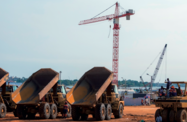The government is placing renewed attention on tackling the housing deficit, with an emphasis on private sector investment, better urban planning and more low-cost homes. Two recently launched projects that dovetail with these aims could point the way for construction development.
The Ghana Housing Profile, authored by the UN Human Settlement Programme in conjunction with the Ministry of Water Resources, Works and Housing (MWWH) and launched on June 20, is a detailed analysis of the country’s urban housing sector, highlighting strengths, weaknesses and future needs.
With 38.3% of the population under the age of 15 in 2010, according to official figures, the next decade will see a rapid growth in the working-age population and further pressure on new housing units. The profile forecasts that Ghana will need another 2m housing units by 2020. Graham Tipple, a UN housing consultant, estimates that 5.7m rooms will be needed, along with supporting infrastructure and utilities.
At the launch of the profile, Nii Nortey Duah, the deputy minister at the MWWH, said the government aimed to increase private sector participation in housing construction through land allocations and low-interest loans in conjunction with Shelter-Afrique, a pan-African financial institution. This should ease impediments to private investment in less expensive homes.
Housing has become an even more pressing concern for the country since the collapse of the Ghana National Housing Project, which was to be undertaken by the South Korean firm STX. The project was scheduled to produce 200,000 units at a cost of $10bn, but after negotiations failed in January, President John Atta Mills announced that the project had fallen through.
The good news is that positive developments are already taking place. On July 7, John Dramani Mahama, the vice-president, launched projects for the construction of two new cities, one in Greater Accra and one in the Western Region, the local press reported. Between them, the projects are worth around $600m.
The former, Appolonia (also known as the City of Light), is sited less than 30 km from central Accra and Kotoka International Airport, and 20 km from the harbour at Tema, Ghana’s largest seaport. The 810-ha site is also close to the highway between Accra and Aburi, which runs northeast from the capital, and thus is positioned in one of Ghana’s centres of urban development. The new “city” will be constructed in phases over 10 years and has a target population of 88,000 on completion.
Renaissance’s second development, King City, is located in North Asaka, just 10 km from Takoradi Harbour, the country’s second port, and part of the twin cities of Sekondi-Takoradi, the heart of Ghana’s rising hydrocarbons industry. It is also 5 km from the Accra-Ivory Coast highway, one of Ghana’s major international transport arteries. The 970-ha site will also be a mixed-use development, aimed at “residential and commercial growth associated with the region’s mining and energy sectors”, the press reported. King City will also be built in phases over the next decade, and has a target population of 90,000.
“We see scope for more of these projects in Ghana, because there is a housing deficit. We are only scratching the surface,” Stephen Jennings, the CEO of Renaissance Group, told OBG.
As Mahama has noted, rapid urbanisation in Ghana requires better spatial planning than has often been the case; many Ghanaian towns and cities are surrounded by poorly planned settlements, with patchy infrastructure and services, and often low-standard housing. Local leaders have also welcomed Appolonia and King City, which are expected to help stimulate economic growth and fit into broader urban development plans. In both cases, Renaissance will establish the master plan, utilities and infrastructure, while the construction of buildings will be left to individuals and investors, following set guidelines.
The projects are particularly significant due to the nature of the investment. While Renaissance is providing the financial resources, local chiefs are providing the land. The so-called “stool land” is communal and usually administered by the chiefs on behalf of the people. Ghana’s complex land ownership situation can make life difficult for investors; deals between those overseeing stool land and developers seem to suit both parties. Renaissance has taken a minimum 50-year lease on both sites.
Secondly, the investment is a vote of confidence in the Ghanaian housing market from the private sector, particularly for properties accommodating lower-income households. Renaissance has said the new towns will have a mix of units, and that it has a deal with a company that can provide 15-year mortgages for GHS18,000 ($10,000) over 15 years, though this is still likely to be out of reach for many Ghanaians.
Thus Appolonia and King City could be important steps for several of the government’s policies: tackling the housing deficit, encouraging private investment in lower-cost residential property, and improving urban development through the construction of new cities. Still, there is much yet to be done. Ghana’s housing deficit is huge and growing, thus concerted government and private sector efforts will be needed to address it.

